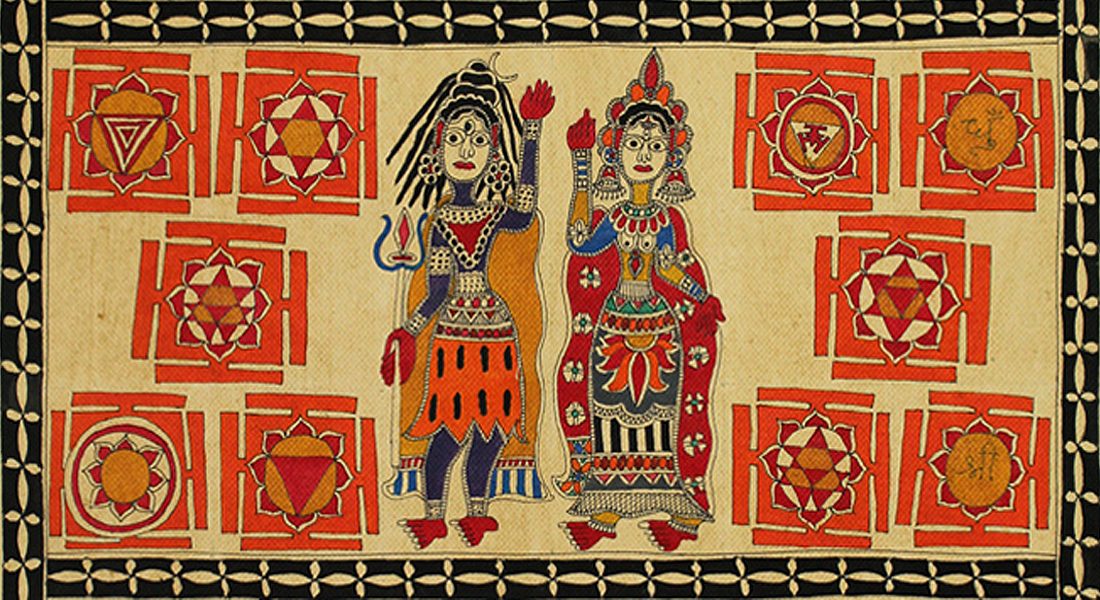Carolyn Henning Brown
California State University, Chico
–
In this article I attempt to unravel a mystery. The mystery is semiotic; it is about layers of meanings; it is about how meanings come into existence and, having once been said and repeated, become “truth”; it is about the power of articulateness over inarticulateness; it is about the gendering of local exegesis; and it is about the colonialism of academic interpretation. The ethnographic puzzle I ponder here is a corpus of ritual art painted by women of North Bihar, India, on the walls of their family compounds. For several decades this corpus has also been reproduced on paper for the international folk-art market. A great deal has been written about this art (Archer 1949; Brown 1982; Jain 1980; Jayakar 1990; Lanius 1982; Mathur 1966; Vequaud 1977), yet the meaning it has for its makers, the women themselves, is obscured by the interpretive agendas brought toit by outsiders.
The issues here speak to several timely concerns for anthropologists. First is the fact that scholars carry their own intellectual preoccupations into the field with them, using the cultural productions of others as icons on which to meditate or as texts to interpret using alien hermeneutics. In recent years scholars have reflected extensively on this ethnographic problem, although the issues are hardly resolved (Asad 1, 986; Bell et al. 1993; Clifford 1988; Clifford and Marcus 1986; Marcus and Fischer 1986; Wolf 1992). To what extent do we reconstruct the material that we are examining through these alien paradigms? How much distortion of meaning are we willing to accept in the name of our own interesting theories?
Second, differently positioned persons or groups in a society may have fundamentally different viewpoints and produce different cultural constructions; yet all engage in meaning making of their own constructions and of one another’s. Another way of saying this is that all members of a society do not share equally in the construction, use, or exegesis of the cultural constructions that might theoretically be available to them. In North Bihar, for example, males of the Maithil Brahman caste control the domain of knowledge about the Shastrik texts and the Vedic rituals based on them. This is “malestream discourse” (Kumar 1994:22), for extraordinarily few women understand the Sanskrit in which the texts are written, and they are frequently kept away from the portions of rituals where the most Sanskritized elements are performed. Women might have interesting things to say about these texts and rituals, but their observations would differ substantially from those of the male “experts.” Similarly, domestic rituals focused on Kula Devi (the lineage goddess) and other goddesses such as Gauri are the women’s domain; men play very minor roles in these rituals and do not produce any of the art that accompanies them. Yet, if asked about them, men do indeed produce interesting commentary, though it is not necessarily what the women would say.
No one is free, it seems, of semiotic urges; and this in itself is an interesting problem for anthropologists. For what, finally, does a thing “mean”? Surely, as Derrida (1991) and others (e.g., Bal 1994) have taught us about texts, a thing (a sign, a text, an icon) means whatever it means to any and all individual human meaning-makers; the “meaning” of a text is the encounter of a reader with that text. But perhaps there is a hierarchy of meanings, even if a tangled one, that an ethnographer ought to sort out if possible. Such is my effort here.
Read Full Version of The Paper I View via Publisher
—
About The Author:
Carolyn Henning Brown (Carolyn Brown Heinz)
Carolyn Brown Heinz is a Professor of Anthropology at California State University, Chico. She has worked in North Bihar since 1980 researching issues of hierarchy, kinship, ritual, and art among the Maithil Brahmans. Her most recent book is Asian Cultural Traditions (Waveland Press, 1999).
–
First published: 21 October 1995
Courtesy: Carolyn Brown Heinz
Credit: academia.edu
https://www.academia.edu/4760139/Tantra_and_the_Poetics_of_Mithila_Art?email_work_card=reading-history
Citation:
Heinz, Carolyn Brown. “Tantra and the Poetics of Mithila Art.” American Ethnologist 23.4 (1996): 717–737. Print.
Other links:
भोजपुरी अंचल (पूर्वांचल) के कोहबर चित्र का वैशिष्टय
Documenting the Image in Mithila Art
Maithil Paintings: An Enquiry into Its Historiographical Trajectory (1947 -1997)
Madhubani Painting: A Historical Context
मिथिला चित्रकला का ‘लोक’ और उसकी प्रवृत्तियां
–
Tags: Carolyn Brown Heinz, David Szanton, Folk painting, Tantra painting, Ganga Devi, Harijan painting, Jyotindra Jain, Mildred Archer, Mithila painting

